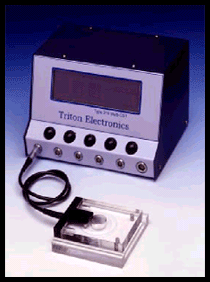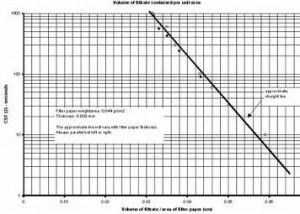|
319 Multi purpose CST Meter
|
|

|
|
| 319 Multi purpose CST Meter |
|
The Triton Type 319 Multi-purpose CST는 5개의 싱글 radius 테스트헤드나 1개의 멀티 radii 테스트 헤드를 사용해 빠릉 측정을 할수 있는 장비임.( rapid assessment of resistance to filtration).
Type 319 CST는 기본적으로 1개의 싱글 측정용 프로브가 포함되어 공급됨.필요하면 추가 구매 가능 .
멀티 테슽 헤드 :별도 구매
멀티테스트 헤드는 각 프로브 사이에 동일한 부피를 주게끔 간격이 설정된 5개의 프로브 셑을 장착한다.
아래 그림에서 볼수 있듯이 표준 buchner funnel을 이용한 비저항 계수(SRF)와 멀티테스트 헤드 사이에는 거의 선형의 상관관계를 보여준다.
멀티테스트 헤드를 사용하게 되면319cst메터는 자동적으로 프롭 갯수만큼 시간을 나눠 버린다.
왜냐하면 여과작업에서는 여과되는 시간과 부피사이에는 포물선관계를 나타내므로 표시값에서의 산술적 차이는 일정하게 직접적으로 비저항에 비례하게 된다.
The multi-radii test head has 5 probes set at intervals to give the same volume between each probe. This is illustrated in the chart below. It has been shown that for a wide range of different types of sludge there is an approximately linear relationship between the specific resistance to filtration, using the standard Buchner funnel apparatus and the multi-radii test head. When using the multi-radii test head the Type 319 unit automatically divides the time by the probe number. Since filtration fulfils the classical parabolic relationship between time and volume of filtrate, then the arithmetic difference in the reading is constant and directly proportional to the specific resistance.

|
| |
Each unit comprises
of:
- 1CST meter
- Perspex block assembly and stainless
steel funnels
- 2Filter papers for immediate
use
- 1 single head
|
|
| |
European and USA EMC standards 기준 만족 |
| |
2-6.1.2 Conditioning Tests. Optimizing chemical dosages is not only important to
the dryness of the cake, but it also affects the solids capture rate and solids disposal
costs. Several types of tests can evaluate the effectiveness of a single conditioning
chemical or group of conditioning chemicals. Standard test procedures include jar tests,
CST tests, Buchner funnel tests, and pilot-scale and on-line testing. Although chemical
dosages should be initially evaluated, they should also be reevaluated periodically
because of changes in sludge characteristics.
2-6.2
Test Procedures. Test procedures that can be used for both basic filterability
testing or conditioning testing include jar tests, CST tests, specific resistivity tests, and
pilot and on-line tests.
2-6.2.1 ?Jar Testing. Jar testing, the simplest type of conditioning testing, is often
used for the preliminary evaluation of the type and estimated quantity of conditioners
required. Jar testing involves the visually observing the size of sludge floc produced
when various types and quantities of different types or combinations of conditioning
chemicals are mixed with samples. This type of testing can be used to screen or elimi-
nate different types of chemical conditioners and determine the effects of different dos-
ages of a specific conditioner. A description of the jar testing procedure is outlined in
Design Manual--Dewatering Municipal Wastewater Sludge (EPA 1987).
2-6.2.2 Capillary Suction Time Testing. The capillary suction time (CST) test
involves measuring the time to move a volume of filtrate over a specified distance as a
result of the capillary suction pressure of dry filter paper. The CST test provides infor-
mation regarding the ease of separating the water portion from the solids portion of
sludge. This type of testing is most effectively used during the selection of the optimum
conditioner dosages during on-line tests. The CST is typically defined in units of time
(seconds). For, example, the typical range of CST for unconditioned organic wastewater
sludge is 100 to 200 seconds (EPA 1987). In general, to dewater this type of sludge in a
filter press, a CST of 10 seconds or less is required. A detailed theoretical description of
this method and its procedures are presented in Design Manual--Dewatering Municipal
Wastewater Sludge (EPA 1987).
2-6.2.3 Specific Resistance Testing. Specific resistance testing has been widely
used and investigated as a way to evaluate the effectiveness of filterability. Specific
resistance is typically defined in units of tetrameters (1012 m) per kilograms (Tm/kg).
The specific resistance for raw wastewater typically ranges from 10 to 100 Tm/kg (1.5 x
1013 to 15 x 1013 ft/lb) (EPA 1987). Generally, the specific resistance can be adjusted by
a factor of 100 to 1000 (e.g., 0.1 to 1.0 Tm/kg [1.5 x 1011 to 15 x 1011 ft/lb]) with proper
conditioning. A lower specific resistance indicates increased dewaterability. This testing
can be done by calculating the specific resistance from Buchner funnel testing or by
measuring the specific resistance directly with specific resistance test meters.
The Buchner funnel test is a method commonly used for predicting the spe-
cific resistance of sludge. A detailed theoretical description of this testing and its pro-
cedures are provided in Design Manual--Dewatering Municipal Wastewater Sludge
(EPA 1987).
2-64
|

